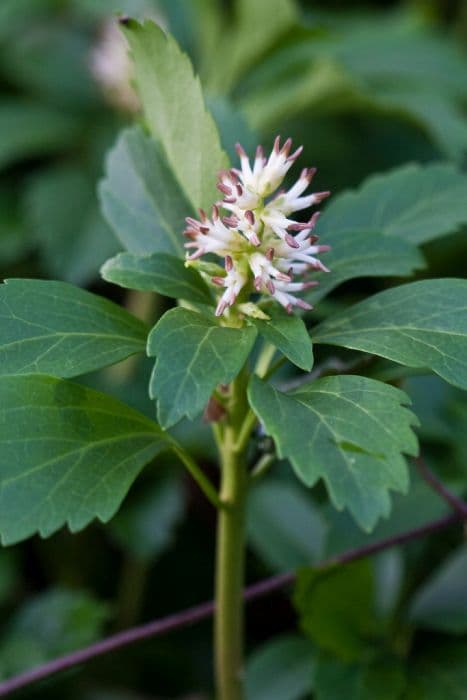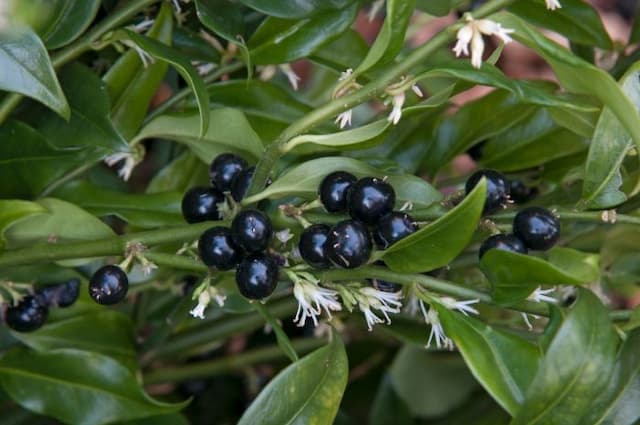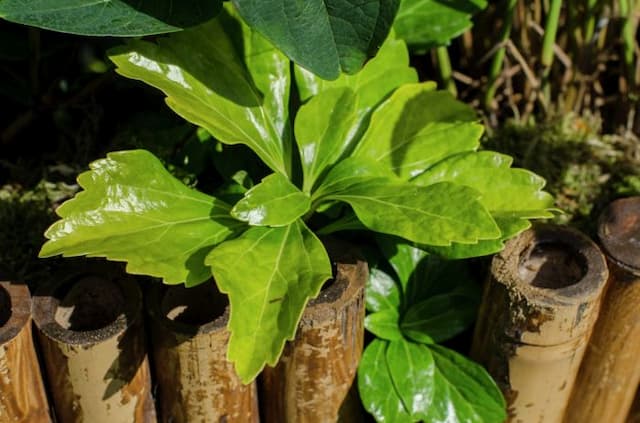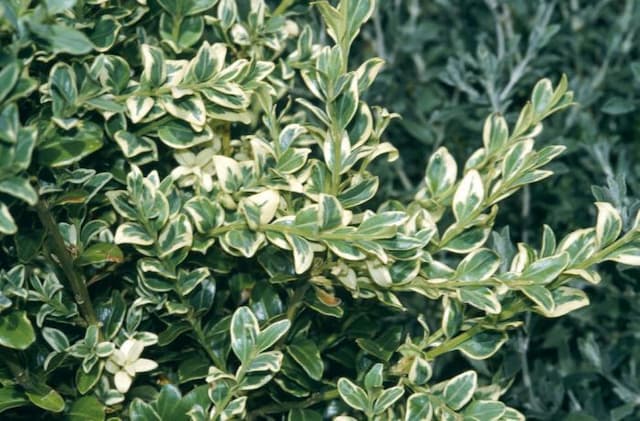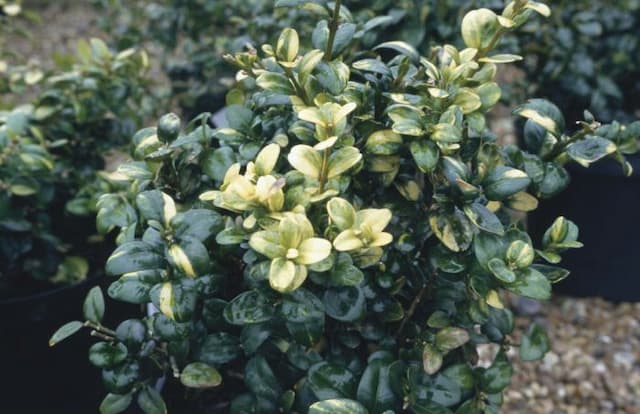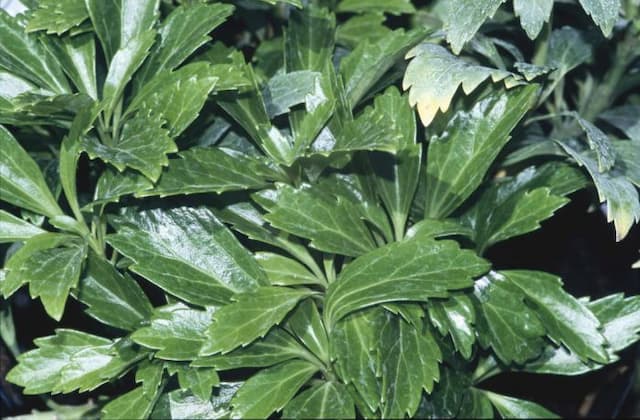Boxwood Buxus sempervirens

ABOUT
Commonly known as the boxwood, this plant is an evergreen shrub that boasts a dense, mounded form. The leaves are small, glossy, and leathery with an elliptical shape and a rich green hue that remains vibrant throughout all seasons. These leaves are arranged in an opposite fashion along the stems, giving the plant a lush, compact appearance. Boxwood has a fine and shallow root system, and the bark is smooth and somewhat pale. The plant produces inconspicuous flowers that are small and creamy to light green in color, contributing little to the plant's ornamental value. It is commonly trimmed into a variety of shapes and sizes for decorative purposes and is a favorite for creating formal garden designs, hedges, and topiaries due to its ability to tolerate heavy pruning and shaping. The overall impression of boxwood is one of classic elegance, often associated with traditional garden landscapes.
About this plant
 Names
NamesFamily
Buxaceae
Synonyms
Common Box, European Box, Boxwood
Common names
Buxus angustifolia, Buxus arborescens, Buxus argentea, Buxus aurea, Buxus balearica, Buxus colchica, Buxus communis, Buxus condensa, Buxus elegans, Buxus ellipticifolia, Buxus florentina, Buxus glomerata, Buxus hyrcana, Buxus latifolia, Buxus longifolia, Buxus macrophylla, Buxus microphylla, Buxus myrtilloides, Buxus neapolitana, Buxus obtusifolia, Buxus palmata, Buxus pyramidalis, Buxus rotundifolia, Buxus sempervirens var. balearica, Buxus sempervirens var. brevifolia, Buxus sempervirens var. fastigiata, Buxus sempervirens var. longifolia, Buxus tomentosa, Buxus valentina, Buxus versicolor, Buxus wallichiana.
 Toxicity
ToxicityTo humans
The common boxwood is toxic to humans if ingested. Its leaves and stems contain alkaloids such as buxine, which can cause nausea, vomiting, diarrhea, dizziness, and convulsions. In severe cases, ingestion may result in respiratory failure and can be fatal. It is important to avoid consuming any part of the common boxwood.
To pets
The common boxwood is also toxic to pets. Ingesting the leaves or stems can cause similar symptoms as in humans, such as vomiting, diarrhea, and potentially leading to seizures or respiratory failure. It is critical to prevent pets from chewing or ingesting any part of the common boxwood to avoid these toxic effects.
 Characteristics
CharacteristicsLife cycle
Perennials
Foliage type
Evergreen
Color of leaves
Green
Height
5-15 feet (1.5-4.5 meters)
Spread
5-15 feet (1.5-4.5 meters)
Plant type
Shrub
Hardiness zones
5-9
Native area
Europe
Benefits
 General Benefits
General Benefits- Evergreen Foliage: Buxus sempervirens, commonly known as boxwood, maintains its greenery throughout the year, providing color and structure in all seasons.
- Topiary and Shaping: Due to its dense growth habit and ease of pruning, boxwood is ideal for creating topiaries, hedges, and other formal garden designs.
- Drought Tolerance: Once established, boxwood is relatively drought tolerant, requiring less frequent watering compared to other plants.
- Shade Tolerance: Boxwood can grow in a variety of light conditions, including shaded areas where other plants might struggle to thrive.
- Deer Resistance: The plant is not a favorite for deer, making it a good choice in areas where deer browsing can be a problem for gardens.
- Soil Adaptability: It is adaptable to a wide range of soil types, although it prefers well-drained soils.
- Windbreaks and Barriers: When planted in rows, boxwood can act as a windbreak or a privacy screen, adding functionality to its ornamental use.
- Historical Significance: With a long history of cultivation, it is often used in historic gardens and can add a sense of tradition to landscapes.
- Pest Resistance: Boxwood is resistant to many pests, though it can still be susceptible to boxwood blight and other diseases.
- Longevity: As a slow-growing plant, boxwood can live for many years and can be considered an investment in the landscape.
 Medical Properties
Medical Properties- Antirheumatic: Historically, Buxus sempervirens, commonly known as boxwood, was used in European folk medicine to treat rheumatic conditions.
- Antiseptic: The plant has been cited to possess antiseptic properties, potentially useful in preventing or combating bacterial infection.
- Antispasmodic: Boxwood has been suggested to relieve spasms of the muscles.
- Antihelmintic: Traditionally, it was used to expel parasitic worms from the body.
- Purgative: In the past, boxwood was used as a strong laxative to cleanse the digestive tract, though it can be toxic.
- Antimalarial: Boxwood has been used in folk medicine as an antimalarial agent.
- Antihyperglycemic: Some sources mention the potential use of boxwood in lowering blood sugar, indicating possible antidiabetic properties.
 Air-purifying Qualities
Air-purifying QualitiesThis plant is not specifically known for air purifying qualities.
 Other Uses
Other Uses- Buxus sempervirens, commonly known as Boxwood, has been traditionally used for woodcarving due to its fine-grain and high-density wood, which lends itself to detailed work and smooth finishes.
- The wood of Boxwood is valued for making musical instruments such as recorders and woodwinds, where consistency and durability of the material affect the sound quality.
- Boxwood is used as a material for printing blocks, particularly before the advent of metal and modern printing materials, due to its ability to hold fine detail without wearing down easily.
- In chess, Boxwood is a classic material for crafting chess pieces, allowing for intricate detailing and a satisfying weight to each piece.
- The plant's dense foliage and ease of shaping make Boxwood a popular choice for topiary art, creating elaborate shapes and designs in formal gardens.
- Landscape designers utilize Boxwood for garden mazes and knot gardens due to its ability to be trimmed into precise lines and hedges, creating complex patterns.
- Boxwood branches and leaves are sometimes used in floral arrangements and wreaths, especially during the holiday season for their evergreen quality and sturdiness.
- Because of its hardness and resistance to splitting, Boxwood is a preferred material for making engraving blocks used in fine art printmaking.
- In marquetry, a craft where pieces of veneer are applied to a structure to form decorative patterns, Boxwood is used for its smooth texture and color contrast.
- Boxwood sawdust and shavings are often used in filling pincushions, as they can help sharpen pins and needles due to the wood's fine texture.
Interesting Facts
 Feng Shui
Feng ShuiThe Boxwood is not used in Feng Shui practice.
 Zodiac Sign Compitability
Zodiac Sign CompitabilityThe Boxwood is not used in astrology practice.
 Plant Symbolism
Plant Symbolism- Eternity: Buxus sempervirens, commonly known as the Boxwood, is an evergreen shrub, which symbolizes eternal life or immortality due to its year-round green leaves.
- Stoicism: With its ability to withstand harsh pruning and still maintain its shape, the Boxwood represents stoicism and the ability to remain undaunted by life's challenges.
- Formality: Boxwood's common use in formal garden designs conveys a sense of order, structure, and formality, indicating discipline and adherence to traditional values.
- Man's Triumph Over Nature: Because Boxwoods can be easily shaped and controlled, they can symbolize humanity's desire and ability to mold and shape the natural world to its will.
 Water
WaterCommonly known as Boxwood, Buxus sempervirens should be watered thoroughly when the top inch of soil feels dry to the touch, typically every one to two weeks depending on climate conditions. Provide enough water to soak the root zone, which could range from a few gallons for young plants to 10 gallons or more for larger, established shrubs. During the growing season, Boxwood may require more frequent watering, especially in hot, dry weather. In winter, reduce watering as the plant's growth slows and the plant requires less moisture. Always ensure that the soil is well-draining to prevent root rot and other water-related issues.
 Light
LightBoxwood thrives in a location with partial to full sunlight but can also tolerate some shade. Ideally, it should receive at least four to six hours of direct sunlight daily but can perform well in bright, indirect light for a portion of the day. Avoid deep shade as this may lead to sparse foliage and a less dense habit.
 Temperature
TemperatureBoxwoods are hardy plants that can survive in a temperature range from as low as 0 degrees Fahrenheit to highs of 90 degrees Fahrenheit. However, the ideal temperature range for Boxwood is between 60 and 70 degrees Fahrenheit. Sudden extreme cold snaps below the survival threshold can damage the plant, so provide protection or move container-grown specimens indoors during harsh winter conditions.
 Pruning
PruningPruning Boxwood keeps it healthy, allows light into the center of the plant, and maintains its desired shape. Prune in late winter or early spring before new growth starts, which is the best time for the plant to heal from cuts. Light trimming can also be done in late summer after the new growth has hardened. Do not prune too late in the season as this can lead to tender new shoots that may be damaged by early frosts.
 Cleaning
CleaningAs needed
 Soil
SoilCommon box (Buxus sempervirens) thrives best in well-drained soil with a pH range of 6.5 to 7.5. A good soil mix for common box would include equal parts of garden soil, peat moss, and sand or perlite to facilitate drainage.
 Repotting
RepottingCommon box should be repotted every 2 to 3 years, and young, fast-growing plants may benefit from annual repotting to accommodate their growth rate.
 Humidity & Misting
Humidity & MistingCommon box prefers moderate humidity levels and can tolerate the natural humidity found in most outdoor environments without requiring additional humidity control.
 Suitable locations
Suitable locationsIndoor
Place common box in bright, indirect light and avoid overly dry air.
Outdoor
Plant common box in partial shade to full sun; protect from harsh winds.
Hardiness zone
5-9 USDA
 Life cycle
Life cycleBoxwood (Buxus sempervirens) begins its life as a seed, which germinates in moist, well-drained soil, typically in spring. Once the seeds sprout, they enter the seedling stage, establishing roots and sprouting the first set of true leaves. As the seedlings grow, they enter the juvenile stage, where they develop a more established root system and begin to form their characteristic dense, evergreen foliage. The transition to the mature stage occurs over several years, during which the plant reaches its full size and shape, starts to flower, and becomes capable of sexual reproduction, producing seeds to complete the cycle. During the mature stage, which can last for many decades, continuous growth and periodic pruning help maintain the desired shape and health of the boxwood. Seasonally, boxwood may enter a dormancy phase in response to cold winter temperatures, slowing down growth and conserving energy until favorable conditions return in spring.
 Propogation
PropogationPropogation time
Early Spring
The most popular method of propagation for the Common Boxwood, scientifically known as Buxus sempervirens, is via semi-hardwood cuttings. This process typically takes place in late summer to early autumn. To propagate, a cutting approximately 4 to 6 inches (10 to 15 centimeters) long is taken from a healthy parent plant. The lower leaves are removed, and the cut end is often dipped in rooting hormone to encourage root development. The cutting is then inserted into a pot filled with a well-draining soil mix, ensuring that the soil stays moist but not waterlogged. The pot is placed in a location with indirect light until the cutting has rooted, usually within a few weeks to a couple of months, at which point it can be gradually acclimatized to direct sunlight and eventually planted into the garden.
